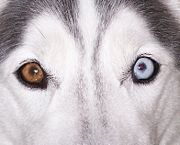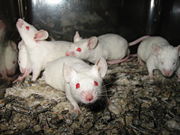Red-eye effect
The red-eye effect in photography is the common appearance of red pupils in color photographs of eyes. It occurs when using a photographic flash very close to the camera lens (as with most compact cameras), in ambient low light. Red-eye effect appears in the eyes of humans and animals that have no tapetum lucidum, hence no eyeshine, and rarely in animals that have a tapetum lucidum. The red-eye effect is a photographic effect, not seen in nature.
Contents |
Causes



Because the light of the flash occurs too fast for the pupil to close, much of the very bright light from the flash passes into the eye through the pupil, reflects off the fundus at the back of the eyeball (see diagram in Eye), and out through the pupil. The camera records this reflected light. The fact that the reflected light is red often is attributed to the ample blood supply of the retina and/or chorium, but this is incorrect. The red-eye effect is due to the color of the fundus, which is due to melanin, a pigment, principally located in the retinal pigment epithelium (RPE).
Although in many animals the RPE is black, in humans it is brown[1]. Red-eye effect is more pronounced in people and animals with lighter colored eyes, especially grey or blue eyes, and in children. In both groups, all tissues of the eye have relatively less melanin. In a pale eye, and in a child's eye, not only does the iris have less melanin to stop stray light from passing through it, but also the retina and choroid have less melanin to absorb stray light that enters the eye. The role of melanin in red-eye effect is most clearly seen in animals with heterochromia: only the blue eye displays the effect. The effect is still more pronounced in humans and animals with albinism. All forms of albinism involve abnormal production and/or deposition of melanin.
Red-eye effect is seen in photographs of children also because children's eyes have more rapid dark adaption: in low light a child's pupils enlarge sooner, and an enlarged pupil accentuates the red-eye effect.
Similar effects

Similar effects, some related to red-eye effect, are of several kinds:

- In many flash photographs, even those without perceptible red-eye effect, many animals' pupils display eyeshine. Although eyeshine is an unrelated effect, animals with blue eyes may display the red-eye effect in addition to eyeshine (see Tapetum lucidum).
- Numerous diseases of the eye cause a "white-eye effect" instead of the expected red-eye effect (see Leukocoria).
- A related effect, red reflex, is seen in fundoscopy; unlike the red-eye effect, it is not a photographic effect.
- In photographs recorded with infrared-sensitive passive (non-IR emitting) equipment, the eyes (not only the pupils) usually appear very bright. This is due not to reflection, but to radiation of core body heat in the form of infrared light (see Night vision).
Photography techniques for prevention and removal
The red-eye effect can be prevented in a number of ways.
- Using bounce flash in which the flash head is aimed at a nearby pale coloured surface such as a ceiling or wall or at a specialist photographic reflector. This both changes the direction of the flash and ensures that only diffused flash light enters the eye.
- Placing the flash away from the camera's optical axis ensures that the light from the flash hits the eye at an oblique angle. The light enters the eye in a direction away from the optical axis of the camera and is refocused by the eye lens back along the same axis. Because of this the retina will not be visible to the camera and the eyes will appear natural.
- Taking pictures without flash by increasing the ambient lighting, opening the lens aperture, using a faster film or detector, or reducing the shutter speed.
- Using ambient light by
- digitally post-processing the image to increase its brightness, or
- Pushing the film development to increase the apparent film speed
- Utilising red-eye reduction capabilities built into many modern cameras. These precede the flash with a series of short, low-power flashes, or a continuous piercing bright light triggering the iris to contract.
- Having the subject not look straight at the camera, instead look at the photographer's shoulder.
- Increase the lighting in the room so that the subject's pupils are more constricted.
- Some computer digital image editors have the ability to lessen the red eye by adding a hint of blue to it.
If direct flash must be used, a good rule of thumb is to separate the flash from the lens by 1/20 of the distance of the camera to the subject. For example, if the subject is 2 metres (6 feet) away, the flash head should be at least 10 cm (4 inches) away from the lens.
Professional photographers prefer to use ambient light or indirect flash as the red-eye reduction system does not always prevent red eyes, for example if people look away during the pre-flash. In addition, people do not look natural with small pupils, and direct lighting from close to the camera lens is considered to produce unflattering photographs.
Various graphics editing software packages have functions to remove red eyes from digital photographs. Some have automated this process, and can apply it to many photos at once. Red-eye removal is also built into many popular consumer programs like Microsoft Windows Vista Photo Gallery, Apple's iPhoto, Google's Picasa, and GIMP. The downside to fully automatic software-based red-eye removal is that it is only accurate to approximately 75%.[2]
External links
- BBC Home, Edited Guide Entry: Determination of Eye Color
- Photocritic.org: Red eye and how to avoid it
References
- ↑ Coscas, Gabriel and Felice Cardillo Piccolino (1998). Retinal Pigment Epithelium and Macular Diseases. Springer. ISBN 0792351444.
- ↑ Raimondo Schettini and Francesca Gasparini and Fadi Chazli: "A modular procedure for automatic red eye correction in digital photos","Color Imaging IX: Processing, Hardcopy, and Applications" 5293, 139-147. SPIE, 2003
|
|||||||||||||||||||||||
|
||||||||||||||||||||||||||||||||